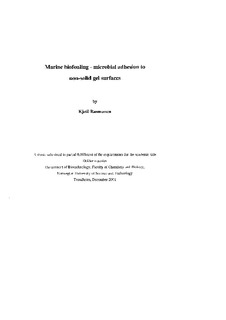| dc.contributor.author | Rasmussen, Kjetil | nb_NO |
| dc.date.accessioned | 2014-12-19T13:14:09Z | |
| dc.date.available | 2014-12-19T13:14:09Z | |
| dc.date.created | 2002-01-25 | nb_NO |
| dc.date.issued | 2002 | nb_NO |
| dc.identifier | 125447 | nb_NO |
| dc.identifier.isbn | 82-471-5385-8 | nb_NO |
| dc.identifier.uri | http://hdl.handle.net/11250/245588 | |
| dc.description.abstract | The scope for this work was to develop rapid assays for enumerating microorganisms on gels, and to test whether fouling of gel surfaces is principally different from that of solid substrata. For this purpose, a standard set of different gels were selected, based on biocompatibility, polymer charge and gel strength.
Bacterial adhesion to gels could be conveniently enumerated by first staining with SYBR Green I nucleic acid gel strain. Images were then collected using a confocal scanning laser microscope, followed by image analysis to determine the percent coverage of bacteria. Diatom adhesion could be qualified using a fluorescence scanner recording the fluorescent chlorophyll, showing a clear correlation between average fluorescence signals and cell density determined by counting. This method was successfully tested on glass, gels, a painted surface and an antifouling coated surface.
Adhesion of the marine bacterium Pseudomonas sp. NCIMB 2021on gels decreased at higher shear rates. At low shear rates, adhesion varied significantly between different gels in the following descending order: alginate > agarose > chitosan > PVA-SbQ. Lowest cell coverage at all shear rates was recorded on the most hydrophobic gel, PVA-SbQ. Earlier work has shown that this organism adhere better to solid hydrophobic than solid hydrophilic surfaces. Thus, other properties than the surface free energy may be more important for bacterial adhesion to the gels.
The marine diatom Amphora coffeaeformis was applied in the different adhesion arrays under different shear conditions. At high shear, cells adhered better to highly ionic polymer gels alginate and chitosan than to the low charge polymer gels agarose and PVA-SbQ. At very low shear, A. coeffeaeformis developed a film even on agarose equivalent to that on the charged polymer gels. Adhesion to PVA-SbQ remained low at all shear rates. As observed for solid substrate, low charge density led to reduced attachment.
Settlement of Balanus amphitrite cypris larvae was tested at different polymer concentrations of the hydrogels. All gels inhibited cypris settlement compared to solid polystyrene controls. Gels consisting of 2.5% PVA-SbQ or 0.5% agarose showed the most promising antifouling properties. In all gel experiments, most of the non-settled larvae were able to settle when transferred and offered a suitable solid substratum. Results indicated that the gel strength was an important factor for cyprid settlement on gels, while the surface wettability seemed to be of minor importance.
A few preliminary field experiments were carried out. These tests suggested that marine bacterial biofilm development is more readily on glass than on a PVA-SbQ gel surface, in accordance with monoculture lab experiments. However, similar amounts of photosynthetic organisms adhered to gels of agorose, alginate, chitosan and PVA-SbQ tested in an outdoor seawater basin during spring bloom. Finally, barnacle settlement was delayed on PVA-SbQ gels exposed in the open sea. After incubation for a full summer season, even those gels became as covered with marine fouling organisms as any other non-toxic surface.
In conclusion, no universal antifouling effects of hydrogels were found. However, this work suggests that both adhesion of a bacterium and settlement of barnacle cypris larvae on gel surfaces may be principally different from solid substrata. Diatom adhesion, on the other hand, was lower on gels with a low charge density, as observed for solid substrata. In general, the most hydrophobic gel, PVA-SbQ, was the least attractive surface for all three organisms. | nb_NO |
| dc.language | eng | nb_NO |
| dc.publisher | Fakultet for naturvitenskap og teknologi | nb_NO |
| dc.relation.ispartofseries | Dr. ingeniøravhandling, 0809-103X; 2001:114 | nb_NO |
| dc.relation.haspart | Rasmussen, K; Vogelsang, C; Østgaard, K. Biofilm formation on non-solid gel surfaces. International Symposium on Environemntl Biotechnology: 393-395, 1997. | nb_NO |
| dc.relation.haspart | Rasmussen, K; Østgaard, K. Adhesion of the marine bacterium Pseudomonas sp. NCIMB 2021 to different hydrogel surfaces. Water Research. 37(3): 519-524, 2003. | nb_NO |
| dc.relation.haspart | Rasmussen, K; Østgaard, K. In situ auto fluorescence detection of a fouling marine diatom on different surfaces. Biofouling. 15: 275-286, 2000. | nb_NO |
| dc.relation.haspart | Rasmussen, K; Østgaard, K. Adhesion of the marine fouling diatom Amphora coffeaeformis to non-solid gel surfaces. Biofouling. 17(2): 103-115, 2001. | nb_NO |
| dc.relation.haspart | Rasmussen, K; Willemsen, P. R; Østgaard, K. Barnacle settlement on hydrogels. Biofouling. 18(3): 177-191, 2002. | nb_NO |
| dc.subject | Biotechnology | en_GB |
| dc.subject | TECHNOLOGY: Bioengineering | en_GB |
| dc.title | Marine biofouling - microbial adhesion to non-solid gel surfaces | nb_NO |
| dc.type | Doctoral thesis | nb_NO |
| dc.contributor.department | Norges teknisk-naturvitenskapelige universitet, Fakultet for naturvitenskap og teknologi, Institutt for bioteknologi | nb_NO |
| dc.description.degree | dr.ing. | nb_NO |
| dc.description.degree | dr.ing. | en_GB |
